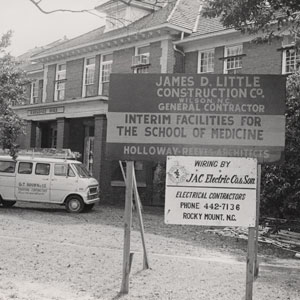
The beginnings of the ECU School of Medicine, later named the Brody School of Medicine, trace back to growing recognition that a shortage in physician care in eastern North Carolina had led to a shameful health care crisis. By all counts, the East was the single most underserved region in North Carolina. When alerted to this, East Carolina president Leo W. Jenkins soon proposed that a state-supported medical school be established in Greenville. East Carolina already had a nursing program, and a longstanding mission of service to the region. In Jenkins’ view, a medical school was much needed and a perfect fit for East Carolina.
Immediate opposition surfaced at the Consolidated University of North Carolina in Chapel Hill, then the only state-supported university. The University was also home to the only state-supported medical school. Adequate health care for eastern North Carolina was at issue, yet still a turf battle ensued pitting the Consolidated University against East Carolina.
Led by its president, William C. Friday, the Consolidated University argued that the best way to address the physician shortage was through expanded funding for Chapel Hill, not a new medical school, much less one at East Carolina. Friday and his allies claimed that even though the shortage was in the East, a medical school’s location did not affect where physicians would practice. Jenkins and his supporters, including state senator Robert Morgan, claimed, to the contrary, that a medical school’s location made all the difference in relation to regional physician care.
While Friday had the backing of the state Board of Higher Education, also based in Chapel Hill, Jenkins took the matter to the press, the people, and ultimately to the state legislature. With crucial help from Morgan and other eastern politicians, Jenkins prevailed in the state legislature first in securing a one-year program, and then a few years later, a two-year program in medicine. Although criticized for politicizing higher education, Jenkins’ response was that everything is political. The victory, however, as Jenkins quickly pointed out, was one for the people of North Carolina, especially those in rural, underserved areas of the East.
A surprising twist came in late 1974 when Friday, then president of the reorganized North Carolina State University System, recommended that ECU, rather than transition to a two-year and then a four-year program, proceed directly to a freestanding, four-year school. Some speculated that Friday was bluffing, challenging Jenkins to fail, especially if he did not have UNC’s assistance. Jenkins and his ECU supporters, however, were elated that Friday had lent the authority of his office to the cause. Earlier, Friday opposed the two-year expansion, but once he saw the political momentum behind it, wholeheartedly lent his support to the ECU cause. The UNC Board of Governor concurred with Friday, as did the state legislature.
Dr. William E. “Bill” Laupus was hired as dean in 1975. Attracted to the challenge, Laupus, a graduate of Yale’s medical school, guided the development of the four-year program. Accreditation came in 1977, and the first class of four-year students entered later that year. Jenkins emphasized that the medical school would privilege qualified North Carolina residents willing to practice primary medicine in the East. As funded, the medical school was also tasked with providing opportunities for minority applicants. Although briefly housed in the Ragsdale Building on the main ECU campus, the medical school soon moved next to Pitt Memorial Hospital (now Vidant), with the construction of new facilities there. Rather than build its own hospital, the medical school partnered with Pitt County Hospital, using it as a teaching facility. The result was a unique and sorely needed addition to higher education in North Carolina, and most especially, improved health care in the rural eastern part of the state.
Sources
- “Agreement Reached By Hospital, ECU.” Statesville Record and Landmark.” June 13, 1975. P. 20.
- Bonds, Lou. “Medical school question, ECU: academics or politics.” The Daily Tar Heel. February 22, 1971. P. 1.
- East Carolina University School of Medicine Collection (LL 02.11), The William E. Laupus Health Sciences Library, East Carolina University, Greenville, North Carolina.
- “ECU Med School Gets Provisional Accreditation.” The Danville Register (Danville, Virginia). April 8, 1977. P. 6.
- ECU School of Allied Health Sciences Collection (LL 02.37), East Carolina Manuscript Collection, J. Y. Joyner Library, East Carolina University, Greenville, North Carolina.
- Edwin Wall Monroe Interview in the Oral History Collection (LL 02.03), The William E. Laupus Health Sciences Library, East Carolina University, Greenville, North Carolina.
- Friedlein, Ken. “4-Year Medical Unit Supported for ECU.” The Atlanta Constitution. November 17, 1974. P. 48.
- Medical Center News and Information Collection (LL 02.07), The William E. Laupus Health Sciences Library, East Carolina University, Greenville, North Carolina.
- Pitt County Memorial Hospital Papers (LL 02.09), The William E. Laupus Health Sciences Library, East Carolina University, Greenville, North Carolina, USA.
- Robert Morgan Papers (#268), East Carolina Manuscript Collection, J. Y. Joyner Library, East Carolina University, Greenville, North Carolina.
Citation Information
Title: School of Medicine
Author: John A. Tucker, PhD
Date of Publication: 7/18/2019